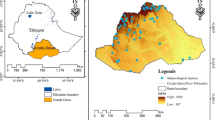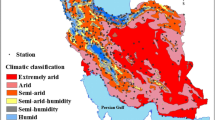Abstract
This study investigates presence/absence of homogeneity in 32-yr (1981–2012) rainfall record of four individual monsoon months (June–September) and monsoon season (JJAS) for 16 stations in Saraswati River basin, Gujarat, India. Temporal homogeneity is examined by Hartley, Link-Wallace, Bartlett, and Tukey tests, and spatial homogeneity is tested by Levene’s and Tukey tests. Coefficient of variation for rainfall in June (72–163%), July (48–100%), August (78–114%) and September (93–127%) indicate a large variability in comparison to that in JJAS period (45–60%). Correlation coefficient (r) finds moderately significant (r ≥ 0.7) to highly significant (0.7 > r ≥ 0.3) relationships in rainfall for 68 (57%), 120 (100%), 120 (100%), 109 (91%), and 120 (100%) pairs of stations in June, July, August, September, and JJAS, respectively. Distribution of rainfall is uniform and stable in July, and hence, kharif crops may be sown in July to mitigate impact of uncertain rainfall on agriculture. Dissimilar results of four homogeneity tests justify approach of adopting multiple statistical tests. Considering the likely findings of Link–Wallace and Tukey tests, both are recommended for testing homogeneity. Non-homogeneity is found at Paswadal (June, September, and JJAS), Navawas (August and JJAS), Palanpur (JJAS), and Pilucha (September) stations. The Levene’s test reveals spatial homogeneity in July, August, September, and JJAS; and non-homogeneity in June. Hierarchical cluster analysis delineates four clusters of rainfall stations in four months and JJAS with their geographically distinct locations and a remarkable difference in inter-annual rainfall dynamics.






Similar content being viewed by others
References
Ahmed A, Deb D and Mondal S 2019 Assessment of rainfall variability and its impact on groundnut yield in Bundelkhand region of India; Curr. Sci. 117(5) 794–803.
Arikan B B and Kahya E 2019 Homogeneity revisited: Analysis of updated precipitation series in Turkey; Theor. Appl. Climatol. 135 211–220.
Ay M 2020 Trend and homogeneity analysis in temperature and rainfall series in western Black Sea region, Turkey; Theor. Appl. Climatol. 139 837–848.
Bintanja R 2018 The impact of Arctic warming on increased rainfall; Sci. Rep. 8 16001, https://doi.org/10.1038/s41598-018-34450-3.
CheRos F, Tosaka H, Sidek L M and Basri H 2016 Homogeneity and trends in long-term rainfall data, Kelantan River Basin, Malaysia; Int. J. River Basin Manag. 14(2) 151–163.
Dave H and James M E 2017 Characteristics of intense rainfall over Gujarat state (India) based on percentile criteria; Hydrol. Sci. J. 62(12) 2035–2048.
Deka R L, Mahanta C, Pathak H, Nath K K and Das S 2013 Trends and fluctuations of rainfall regime in the Brahmaputra and Barak basins of Assam, India; Theor. Appl. Climatol. 114(1–2) 61–71.
Frich P, Alexander L V, Della-Marta P, Gleason B, Haylock M, Klein Tank A M G and Peterson T 2002 Observed coherent changes in climatic extremes during the second half of twentieth century; Clim. Res. 19 193–212.
Ghosh S, Das D, Kao S-C and Ganguly A R 2012 Lack of uniform trends but increasing spatial variability in observed Indian rainfall extremes; Nat. Clim. Change 2 86–91.
Gupta A, Kamble T and Machiwal D 2017 Comparison of ordinary and Bayesian kriging techniques in depicting rainfall variability in arid and semi-arid regions of northwest India; Environ. Earth Sci. 76 512, https://doi.org/10.1007/s12665-017-6814-3.
Haigh M J 2004 Sustainable management of head water resources: The Nairobi head water declaration (2002) and beyond; Asian J. Water, Environ. Pollut. 1(1–2) 17–28.
Hänsel S, Medeiros D M, Matschullat J, Petta R A and de Mendonça Silva I 2016 Assessing homogeneity and climate variability of temperature and precipitation series in the capitals of north-eastern Brazil; Front. Earth Sci. 4 29, https://doi.org/10.3389/feart.2016.00029.
Huang J, Ji M, Xie Y, Wang S, He Y and Ran J 2016 Global semi-arid climate change over last 60 years; Clim. Dyn. 46 1131–1150.
India-WRIS 2014 West Flowing Rivers of Kutch and Saurashtra including Luni Basin; Version 2.0, Report of Joint Project of Central Water Commission; Ministry of Water Resources, New Delhi and National Remote Sensing Centre, Indian Space Research Organization, Hyderabad, Government of India on Generation of Database and Implementation of Web enabled Water Resources Information System in the Country (India-WRISWebGIS), 135p.
Kanji G K 2001 100 Statistical tests; Sage Publication, New Delhi, India.
Khandelwal M K, Arora S and Raju K C B 2013 Spatial and temporal variations in rainfall and rainwater harvesting potential for Kutch district, Gujarat; J. Soil Water Conserv. 12(2) 117–122.
Kocsis T, Kovács-Székely I and Anda A 2020 Homogeneity tests and non-parametric analyses of tendencies in precipitation time series in Keszthely, Western Hungary; Theor. Appl. Climatol. 139 849–859.
Kumar S, Machiwal D and Parmar B S 2019 Parsimonious approach to delineate groundwater potential zones using geospatial modeling and MCDA techniques under limited data availability condition; Eng. Rep. 1(5) e12073, https://doi.org/10.1002/eng2.12073.
Levene H 1960 Robust tests for equality of variances; In: Contributions to Probability and Statistics: Essays in Honour of Harold Hotelling (eds) Olkin I, Ghurye S G, Hoeffding W, Madow W G and Mann H B, Stanford University Press, Palo Alto, California, pp. 278–292.
Li Z, Li X, Wang Y and Quiring S M 2019 Impact of climate change on precipitation patterns in Houston, Texas, USA; Anthropocene 25 100193, https://doi.org/10.1016/j.ancene.2019.100193.
Machiwal D and Jha M K 2012 Hydrologic Time Series Analysis: Theory and Practice; Springer, Netherlands and Capital Publishing Company, New Delhi, India, 303p.
Machiwal D and Jha M K 2017 Evaluating persistence, and identifying trends and abrupt changes in monthly and annual rainfalls of a semi-arid region in western India; Theor. Appl. Climatol. 128(3–4) 689–708.
Machiwal D, Kumar S and Dayal D 2016 Characterizing rainfall of hot arid region by using time-series modeling and sustainability approaches: A case study from Gujarat, India; Theor. Appl. Climatol. 124 593–607.
Meena H M, Machiwal D, Santra P, Moharana P C and Singh D V 2019 Trends and homogeneity of monthly, seasonal, and annual rainfall over arid region of Rajasthan, India; Theor. Appl. Climatol. 136(3–4) 795–811.
Otto M 1998 Multivariate methods; In: Analytical Chemistry (eds) Kellner R, Mermet J M, Otto M and Widmer H M, Wiley VCH, Weinheim, Germany, 916p.
Panda A and Sahu N 2019 Trend analysis of seasonal rainfall and temperature pattern in Kalahandi, Bolangir and Koraput districts of Odisha India; Atmos. Sci. Lett. 20(10) e932, https://doi.org/10.1002/asl.932.
Pisal R R, Kumar N and Shukla S P 2017 Long term trend analysis of rainfall at heavy rainfall zone of South Gujarat, India; Indian J. Soil Conserv. 45(2) 168–175.
Pradhan R K, Sharma D, Panda S K and Sharma A 2019 Changes of precipitation regime and its indices over Rajasthan state of India: Impact of climate change scenarios experiments; Clim. Dyn. 5(5–6) 3405–3420.
Praveenkumar Ch and Jothiprakash V 2020 Spatio-temporal trend and homogeneity analysis of gridded and gauge precipitation in Indravati River basin, India; J. Water Clim. Change 11(1) 178–199.
Priyan K 2015 Spatial and temporal variability of rainfall in Anand district of Gujarat state. International Conference on Water Resources, Coastal and Ocean Engineering (ICWRCOE 2015); Aquat. Procedia 4 713–720.
Rahman M A, Yunsheng L and Sultana N 2017 Analysis and prediction of rainfall trends over Bangladesh using Mann-Kendall, Spearman’s rho tests and ARIMA model; Meteor. Atmos. Phys. 129(4) 409–424.
Ratner B 2009 The correlation coefficient: Its values range between +1/−1, or do they?; J. Target. Meas. Anal. Market. 17(2) 139–142.
Sonali P and Kumar D N 2013 Review of trend detection methods and their application to detect temperature changes in India; J. Hydrol. 476 212–227.
StatSoft Inc 2004 STATISTICA (Data Analysis Software System); version 6, www.statsoft.com.
Zhang Q, Xu C-Y, Becker S, Zhang Z X, Chen Y D and Coulibaly M 2009 Trends and abrupt changes of precipitation maxima in the Pearl River Basin, China; Atmos. Sci. Lett. 10 132–144.
Zhang Q, Xu C-Y, Zhang Z, Chen X and Han Z 2010 Precipitation extremes in a karst region: A case study in the Guizhou Province, southwest China; Theor. Appl. Climatol. 101 53–65.
Acknowledgements
First author acknowledges all facilities provided by the Director, ICAR-Central Arid Zone Research Institute, Jodhpur, India for carrying out this study. The authors are grateful to the anonymous reviewer for their constructive suggestions, which greatly enhanced the quality of an earlier version of this paper.
Author information
Authors and Affiliations
Contributions
Deepesh Machiwal: Conceptualization, methodology, formal analysis, investigation, interpretation of results, writing and editing manuscript. B S Parmar: Data and resources. Sanjay Kumar: Resources and GIS figures. Hari Mohan Meena: Review, methodology. B S Deora: Supervision.
Corresponding author
Additional information
Communicated by Kavirajan Rajendran
Rights and permissions
About this article
Cite this article
Machiwal, D., Parmar, B.S., Kumar, S. et al. Evaluating homogeneity of monsoon rainfall in Saraswati River basin of Gujarat, India. J Earth Syst Sci 130, 181 (2021). https://doi.org/10.1007/s12040-021-01671-6
Received:
Revised:
Accepted:
Published:
DOI: https://doi.org/10.1007/s12040-021-01671-6




